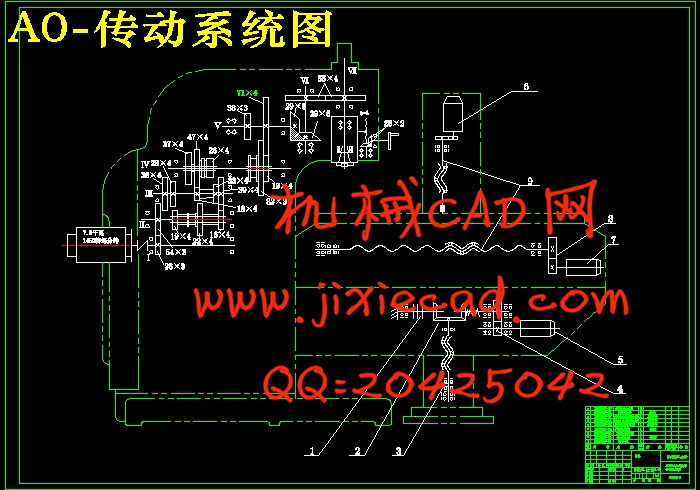设计简介
摘 要
从研究铣床着手,借鉴国内外先进经验,设计了一台XK5036数控立式铣床,满足了生产和设计的要求。XK5036数控立式铣床整个铣床主要包括横纵向进给机构、垂直进给机构、立柱、横梁、底座、工作台等主要组部件。其中所有进给机构均采用滚珠丝杠进行传动,并由伺服电机进行驱动。主轴箱安装在门架上,运用类比法自行设计了滚珠丝杠螺母副的制动装置。全面阐述了数控铣床的结构原理,设计特点,论述了采用伺服电机和滚珠丝杠螺母副的优点。详细介绍了数控铣床的结构设计及校核,并进行了分析。另外汇总了有关技术参数。其中XK5036横向进给传动机构设计着重介绍了横向进给机构,横向进给机构主要通过滚珠丝杠执行完成的,重点介绍了滚珠丝杠的原理及选用原则,系统地对滚珠丝杠生产、应用等环节进行了介绍。包括种类选择、参数选择、精度选择、循环方式选择、与主机匹配的原则以及厂家的选择等。
关键词:铣床,数控,伺服电机,滚珠丝杠
Abstract
Started from the study of milling machine, referring to the domestic and foreign advanced experience, to design a XK5036 CNC vertical milling machine, to meet the requirements of production and design. XK5036 CNC vertical milling machine milling machine mainly comprises the entire transverse and longitudinal feed mechanism, a vertical feed mechanism, column, beam, a base, etc. the main component of working table. All of which feed mechanism adopts the ball screw drive, and is driven by servo motor. The spindle box is arranged on the door frame, by using the method of analogy to design their own ball screw nut pair of braking device. Comprehensively expounds the structure principle, CNC milling machine design features, discusses the advantages of using a servo motor and a ball screw nut pair. Introduces the structure design and verification of CNC milling machine, and analyses the. In addition, a summary of the relevant technical parameters.The design of XK5036 transverse feed transmission mechanism introduced emphatically the transverse feed mechanism, a transverse feed mechanism mainly through ball screw has finished executing, emphatically introduces the principle and the selection principle of ball lead screw, ball screw system on the production and application of such links are introduced. Including the principles and manufacturers selection, parameter selection, selection accuracy, cycle mode choice, and matching host selection.
Key Words: milling machine, Numerical control, Step-by-step, serve motor, Ball bearing guide screw nut
目 录
Abstract III
目 录 IV
第1章 数控机床发展概述 1
1.1 数控机床及其特点 1
1.1.1 数控机床与普通机床的区别 1
1.1.2 数控机床的适用范围 2
1.2 数控机床的工艺范围及加工精度 2
1.3数控机床的经济分析 3
1.3.1控制系统的选择 4
1.3.2 选择设计对象要适宜 4
1.3.3 机床的机械设计范围要适当 5
1.3.4 辅助设计要合适 5
1.4 数控机床发展趋势 6
第2章 数控机床总体方案的制订及比较 8
2.1总体方案设计的内容 8
2.2 设计方案的确定 8
第3章 确定切削用量及选择刀具 11
3.1 科学选择数控刀具 11
3.1.1 选择数控刀具的原则 11
3.1.2 选择数控车削用刀具 11
3.1.3 选择数控铣削用刀具 12
3.2 设置刀点和换刀点 12
3.3 确定切削用量 13
3.3.1 确定主轴转速 13
3.3.2 确定进给速度 13
3.3.3 确定背吃刀量 13
第4章 传动系统图设计 14
4.1 参数的拟定 14
4.2 传动结构或结构网的选择 14
4.3 转速图拟定 16
4.4 齿轮齿数的确定及传动系统图的绘制 19
第5章 横向进给传动机构装配图和零件图的设计计算 24
5.1设计方案的确定 24
5.2 进给滚珠丝杆副的选择 24
5.2.1 导程确定 24
5.2.2 确定丝杆的等效转速 25
5.2.3 估计工作台质量及负重 25
5.2.4 确定丝杆的等效负载 25
5.2.5 确定丝杆所受的最大动载荷 25
5.2.6 精度的选择 26
5.2.7 选择滚珠丝杆型号 27
5.3 校核 27
5.3.1 临界压缩负荷验证 27
5.3.2 临界转速验证 28
5.3.3 丝杆拉压振动与扭转振动的固有频率 28
5.4 电机的选择 29
5.4.1 电机轴的转动惯量 29
5.4.2 电机扭矩计算 30
结 论 32
致 谢 33
参考文献 34





